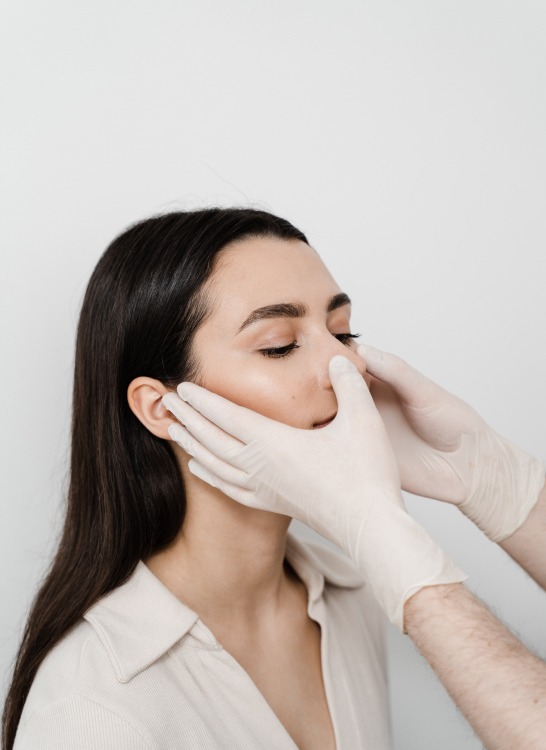Deviated Nasal Septum(DNS)

A Deviated Nasal Septum (DNS) occurs when the thin wall (nasal septum) between the nasal passages is displaced to one side. This can lead to nasal obstruction, breathing difficulty, frequent sinus infections, headaches, and snoring.
Common Symptoms of Deviated Nasal Septum
- Blocked or congested nostril (especially one-sided)
- Difficulty breathing through the nose
- Frequent sinus infections or headaches
- Nasal discharge or postnasal drip
- Snoring and disturbed sleep
- Facial pain or pressure
At Chakrasiddh, therapy helps in clearing blockages in the nasal passages using natural, non-invasive therapies that target the root cause of septum deviation
Key highlights for DNS treatment:
1. Nasyam (nasal administration of specific medicated oils in and around nasal area):
- Clears nasal blockages
- Reduces inflammation and soothes mucosal lining
- Promotes free airflow through nasal passages
- Improves blood circulation
- Reduces chronic inflammation
2. Varmam Therapy (energy point therapy):
- Enhances nerve function and reduces nasal sensitivity
- Supports better breathing and sinus drainage
3. Nasal Manipulation Therapy (correction of deviated septum by finger pressure):
- Increases space and reduces blockages
- Supports sinus drainage
4. Steam Inhalation: (suggested after every therapy 2-3 times)
- Loosens mucus
- Reduces sinus congestion
- Helps open up nasal pathways
Improvements Observed with Therapy:
- Reduced nasal congestion and easier breathing
- Decreased frequency of sinus infections
- Relief from headaches and facial pressure
- Improved sleep quality due to less snoring
- Aesthetic enhancement
- Better immunity and overall respiratory health
Note: Siddha therapies are highly beneficial in managing symptoms, reducing dependency on nasal sprays, and supporting post-surgical recovery. In severe cases where accidental harm to the septal deviation is there, surgical correction (septoplasty) might be required.
Causes and Risk Factors of Septum Deviation
Several factors can contribute to septum deviation, including:
- Congenital factors – Some people are born with a naturally off-center nasal septum.
- Traumatic injuries – Accidents, sports injuries, or falls can shift the nasal septum.
- Nasal inflammation – Chronic sinusitis or allergic rhinitis can aggravate symptoms of deviated nasal septum.
Aging process – Changes in bone structure over time may worsen a mild deviation.
Why Treating Deviated Nasal Septum is Important
Leaving septum deviation untreated can lead to:
- Frequent or chronic sinus infections due to poor drainage
- Disturbed sleep and increased risk of sleep apnea
- Reduced sense of smell
- Constant headaches or facial pressure
- Dryness and crusting inside the nasal passages
Early intervention helps in preventing complications and improving the quality of life.
Frequently Asked Questions
Is a deviated septum serious?
A deviated septum is often mild and only occasionally affects quality of life. However, when it’s severe and blocks one or both nasal passages, it can lead to chronic sinus infections, disturbed sleep, mouth breathing, or frequent nosebleeds—making it more serious and diminishing overall well-being.
How do you fix a deviated septum?
For those with significant symptoms, septoplasty is the standard surgical method to straighten the septum and improve airflow—typically completed in under 90 minutes. Mild to moderate cases can be managed with topical treatments like decongestants, antihistamines, or saline rinses, though these only alleviate symptoms and do not correct the deviation. At Chakrasiddh, we also offer gentle therapies such as Nasyam, Varmam, and nasal manipulation to naturally reduce symptom severity and improve drainage.
How does a deviated nasal septum occur?
A deviant nasal septum can be congenital—present from birth—or develop due to injury (e.g., trauma, accidents, or childbirth-related pressure). As we age, cartilage weakening or previous inflammation (like repeated sinus infections) may worsen the deviation. Septum deviation can therefore emerge or worsen over time.
Can a deviated nasal septum be cured?
While structural deviation remains permanent, its symptoms can be significantly managed. Septoplasty offers a long-term structural correction, whereas non-surgical treatments and Siddha therapies can reduce symptoms and improve airflow without invasive procedures—especially for mild cases
